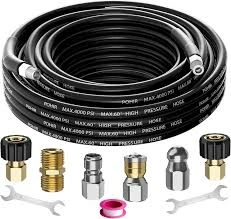Rubber Brake Line Maintenance and Replacement Tips for Safety and Performance
Understanding Rubber Brake Lines Importance and Maintenance
Rubber brake lines are a fundamental component of any vehicle's braking system. They play a crucial role in ensuring that the vehicle can stop safely and effectively. Comprised of durable rubber materials, these brake lines are designed to handle high pressure and resist wear from various environmental factors. In this article, we will explore the importance of rubber brake lines, their construction, common issues, and the best practices for maintenance.
The Importance of Rubber Brake Lines
The primary function of rubber brake lines is to transport brake fluid from the master cylinder to the brake calipers or wheel cylinders. When a driver presses the brake pedal, the force is transferred through the brake fluid via these lines to activate the brakes. This hydraulic system allows for smooth and efficient braking, which is essential for safety on the road.
Rubber brake lines are preferred in many vehicles due to their flexibility and resistance to vibrations and shocks. This flexibility is particularly important because it allows for movement of the suspension system during driving. However, while they are effective, these lines can be susceptible to wear and tear, particularly in demanding conditions.
Construction and Material
Rubber brake lines are typically made from synthetic rubber blended with other materials to enhance their durability and heat resistance. The inner layer is designed to withstand high pressure and is usually coated to prevent degradation from brake fluid. The outer layer acts as a protective barrier against abrasion, UV light, and corrosive elements such as dirt, salt, and moisture.
In higher-end vehicles, you may also find braided stainless steel brake lines, which offer superior performance by providing enhanced strength and resistance to expansion under pressure. While they may be more costly, the performance benefits can be significant, especially in high-performance driving or racing.
Common Issues with Rubber Brake Lines
Over time, rubber brake lines can develop several issues due to exposure to heat, moisture, and the corrosive nature of brake fluid. Some of the most common issues include
1. Cracking and Dry Rot Prolonged exposure to UV light and high temperatures can cause the rubber to crack or dry out, compromising the integrity of the brake line.
rubber brake line

2. Bulging If the internal pressure exceeds what the line can handle, it may bulge. This is a warning sign that the line may rupture, leading to brake failure.
3. Fluid Leaks Any damage to the brake line can result in leaks, which diminishes braking performance and can expose other components to fluid contamination.
4. Kinking or Twisting Improper installation or damage from external forces can lead to kinks or twists in the line, disrupting the flow of brake fluid and affecting overall performance.
Maintenance and Best Practices
To ensure the longevity and reliability of rubber brake lines, regular inspection and maintenance are essential. Here are some best practices to follow
1. Routine Checks Examine brake lines for signs of wear, such as cracking, discoloration, or leaks. This should be part of your regular vehicle maintenance routine.
2. Fluid Replacement Ensuring that the brake fluid is changed per manufacturer recommendations can help prevent damage due to contamination and moisture absorption.
3. Professional Inspection Have your brake system inspected by a qualified mechanic at least once a year, especially if you notice any changes in braking performance.
4. Timely Replacement If you observe any damage to the brake lines, replace them immediately to avoid compromising safety.
In conclusion, rubber brake lines are a critical element of vehicle safety and performance. Understanding their function, recognizing potential issues, and committing to regular maintenance can help ensure that your braking system operates effectively. A well-maintained brake system not only contributes to safer driving but also enhances the overall longevity of your vehicle. Prioritizing the health of your rubber brake lines is a smart investment in automotive safety.
-
Ultimate Spiral Protection for Hoses & CablesNewsJun.26,2025
-
The Ultimate Quick-Connect Solutions for Every NeedNewsJun.26,2025
-
SAE J1401 Brake Hose: Reliable Choice for Safe BrakingNewsJun.26,2025
-
Reliable J2064 A/C Hoses for Real-World Cooling NeedsNewsJun.26,2025
-
Heavy-Duty Sewer Jetting Hoses Built to LastNewsJun.26,2025
-
Fix Power Steering Tube Leaks Fast – Durable & Affordable SolutionNewsJun.26,2025

